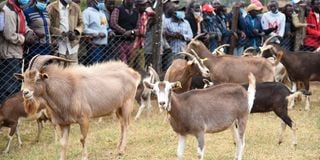Dear farmer, your dairy goat does not need to be rounded

Dairy goats on auction in Moiben, Uasin Gishu County.
The call found me in Murang’a County last Saturday inspecting my super Napier after delivering 10 emaciated dairy heifers to the farm.
I had bought the cattle from Kiambu County to rehabilitate them and restore their body condition.
Thanks to mobile telephony, I am able to travel far away and still serve farmers through my office team or our network of associate veterinary doctors and veterinary paraprofessionals or paravets.
The caller’s voice was very familiar even though I had not talked to my university professor and colleague Njenga for almost five years.
From the tone of his greetings, I was certain there was a problem he needed addressed urgently.
Njenga quickly explained that the family of a recently departed colleague had called in distress.
Their dairy goats were seriously sick with diarrhoea that had set in rapidly that morning, killing one. The remaining were not in good shape.
Njenga told me he no longer did clinical practice and would be happy if I responded to the distress.
You see, as veterinary doctors advance in their careers, some diversify into areas like management, administration, marketing and project management where they have no room for clinical practice.
Njenga is a top administrator of a local university.
I called a colleague – Dr Mwikali – who was on duty and briefed her on the case. It was an emergency that needed urgent attention.
Mwikali promptly attended to the goats and narrated her findings to me later in the day.
She had found one goat critically sick – with copious bloody diarrhoea. The animal could not stand.
The goat had continuously lost blood for about six hours. Its mucous membranes were pale and it had a high fever.
The prognosis for the case was guarded.
In plain terms, this means the animal could survive or die despite treatment.
Mwikali first treated the very sickly goat, based on her findings before she took full history of the case and examined the other animals.
The owner of the goats explained that they had been healthy and were promptly treated by the departed doctor in the past.
Personally, I recall he was very fond of his goats.
The illness had started the previous day with sluggishness and decreased appetite.
That morning, the animals stopped eating altogether and started having diarrhoea that progressed into dysentery or bloody diarrhoea in the very sick goat.
Mwikali enquired what feed changes may have occurred in the last two weeks.
She was informed that the farmer had noticed the goats were thin and had mostly fed on grass hay. She took the decision to improve the animals’ body condition by feeding a high carbohydrate diet.
She started giving rabbit pellets a week earlier and the goats appeared to love it.
Mwikali carried out postmortem on the carcass.
She found bleeding in the small and large intestines. There was some blood-coloured fluid in the abdominal cavity too.
The doctor examined the other goats and found they had signs of illness similar to those of the very sick animal.
She diagnosed enterotoxaemia, an illness caused by clostridium bacteria and treated the goats with injected antibiotics.
She also gave antibiotics by mouth to control bacterial growth in the digestive tract and injected anti-inflammatories to control tissue damage by the toxins.
The doctor closed the visit by explaining to the farmer enterotoxaemia disease and the nature of the dairy goat body.
Enterotoxaemia is also called the “over-eating disease of sheep and goats”.
It is caused by the Clostridium perfrigens bacteria when it vigorously proliferates in the intestines due to changes in the animal’s diet.
The bacteria is found in the intestines of sheep, goats, cattle and even humans.
When carbohydrates are suddenly eaten in large quantities, the micro-organism multiplies rapidly and produces lots of toxins.
The toxins damage the intestinal walls and get into the bloodstream. They are then distributed to all body organs.
They cause damage to the organs, including the brain.
Animals that produce a large quantity of toxins that are distributed in the body often drop dead without showing signs of illness.
Moderate toxin production shows signs of illness as seen in the cases Mwikali attended to.
Some animals may also show pain in the stomach such as kicking their bellies, lying on the side or rolling and repetitive vocalisation.
When moderate quantities of toxins reach the brain, animals may show staggering gait.
They may also lie down and throw the head over the shoulders.
The best way to prevent enterotoxaemia is to vaccinate sheep, goats and cattle against the toxin.
Feeding should also be managed to avoid heavy intake of high carbohydrate at once.
These include grains, lush grass and milk. Enhanced feeding of high carbohydrate should be gradual to allow the useful bacteria in the gut to multiply and limit the multiplication of the clostridium bacteria.
Sheep and goats should have limited access to lush pasture and the daily grazing hours should be increased slowly.
Animals should be fed dry hay before being introduced in lush pasture or being fed high carbohydrate diets like grains.
Mwikali finally advised the farmer that dairy goats are made for lean bodies to ensure maximum milk production.
They, therefore, never get rounded with meat and fat like the meat goats.





